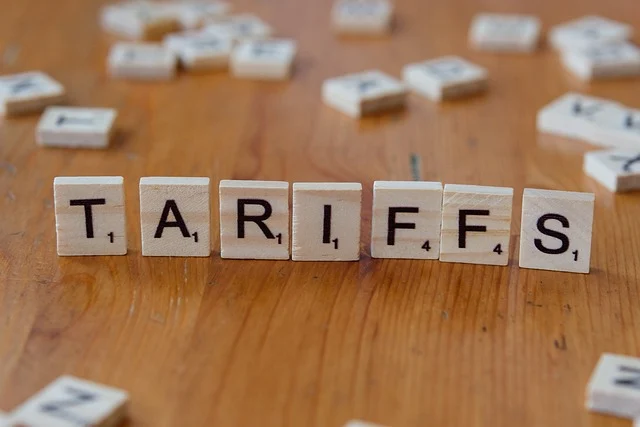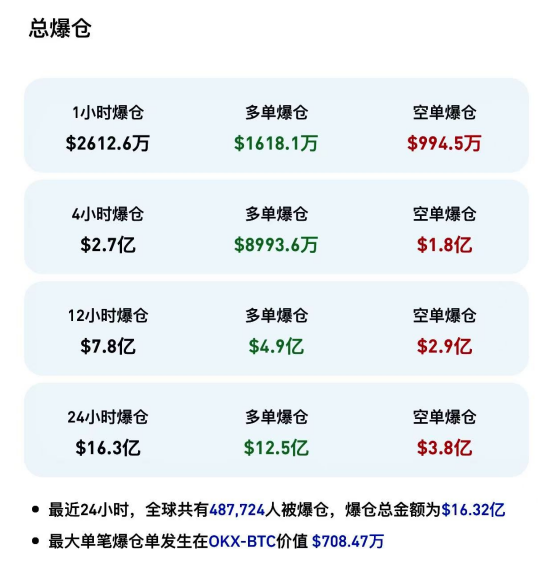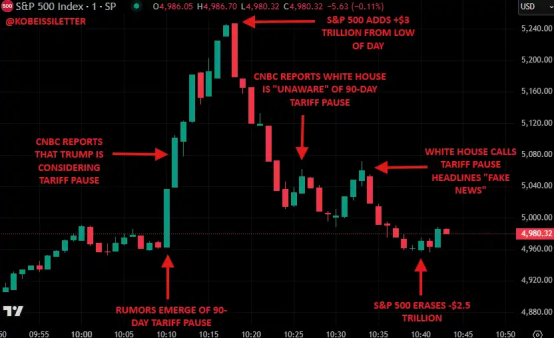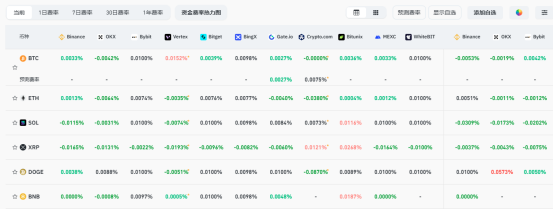The crypto market reappears on "Black Monday": More than 480,000 people have lost their positions, and when will the tariff haze be over?

Reprinted from panewslab
04/08/2025·1M
The force of reciprocal tariffs is more intense than expected.
On Monday, the global financial markets ushered in a huge shock. The three major U.S. stock indexes continued to plummet, and stock markets such as Europe and Asia plummeted, and the commodity market was not spared. Crude oil and gold fell simultaneously, and cryptocurrencies were difficult to resilient again. Bitcoin fell by more than 10% in two days, and Ethereum even fell by 20%. The global financial market showed a "green" scene.
In response to this, Trump, the culprit, expressed his calmness and described the current market reaction by "taking medicine when you are sick", but is this move cured the disease or to quench thirst? When will the impact on the market be repaired? The storm is about to come and the global market is shrouded in.
On April 2, US President Trump signed two executive orders on so-called "reciprocal tariffs" at the White House, announcing that the United States set a 10% "minimum benchmark tariff" on trading partners and imposed higher tariffs on some trading partners, officially kicking off the reciprocal tariffs.
If the world only used reciprocal tariffs as Trump's negotiation method at that time, now, we can probably see the greedy ambitions at the tip of the iceberg behind Trump, because the price paid for this move is really not small.
After the reciprocal tariffs, my country took the lead in countering the Tariff Commission of the State Council, the Ministry of Commerce, and the General Administration of Customs successively issued a number of countermeasures against the United States, announcing that from 12:01 on April 10, the Tariff Commission of the State Council will impose a 34% tariff on imported goods originating from the United States on the basis of the current applicable tariff rate, and signs of a global trade war begin to appear.
On April 7, the reciprocal tariff storm became increasingly fierce, and the global financial market ushered in an epic sharp drop. US stock futures continued the plunge trend last week, with Nasdaq futures falling by more than 5%, and S&P 500 futures falling by more than 4%; the market value of US stocks plunging in two trading days is basically equal to the sum of Germany and South Korea's GDP in 2024. European stock index futures also fell sharply, with European STOXX50 index futures falling by more than 4%, and DAX index futures falling by nearly 5%. The Asian market was not spared, and the Japanese and Korean stock markets collapsed again, the South Korean comprehensive index fell by more than 4% at the opening, and the Nikkei 225 index fell by nearly 2%. The Hang Seng Index closed at 19828 points, down 3021 points throughout the day, a drop of 13.2%, setting a record single-day decline since October 28, 1997.
The crypto market has also ushered in a bloody storm. Bitcoin fell by more than 10% in two days, and once fell below $75,000 on the same day. The copycat collapsed completely, Ethereum fell below $1,500, and SOL reached at least $100. Coinglass data shows that yesterday, a total of 487,700 people around the world lost their positions, with the amount of liquidated more than US$1.632 billion, of which US$1.25 billion were long positions and US$380 million were short positions.

It is enough to see that global confidence has dropped to freezing point, panic has skyrocketed, and the US recession has once again become the center of public opinion. Canadian Prime Minister Carney said the United States is in recession due to President Trump's radical tariff actions. Larry Fink, CEO of US asset management giant BlackRock, also agreed, stressing that many business leaders believe that the US economy may have fallen into a serious recession. Business perceptions are surprisingly consistent. According to a survey by US media, 69% of business leaders expect an economic recession in the United States, and more than half of them say the recession will arrive this year.
In fact, there are many complaints around the world, and there are also jokes that Trump is shorting the United States. If it is just a means of negotiation, it will have been too effective. US government officials revealed that more than 50 economies are currently in contact with the United States on tariff policies. Vietnam has even proposed a zero-tax strategy to show weakness. The EU has also changed its tough attitude and proposed that both sides exempt tariffs from each other. But Trump was not satisfied with this and spoke out again that he would "will not suspend tariffs."
In terms of reasons, reciprocal tariffs undoubtedly have three major purposes. First, it is to reverse the trade imbalance and trade deficit that the United States emphasizes particularly; second, it is to increase US fiscal revenue. In the current federal tax revenue structure, personal income tax and corporate income tax are the core components, and the proportion of tariffs is extremely low. Trump tried to increase the proportion of tariffs to about 5%, and it is expected to add about US$700 billion in US fiscal revenue; third, it is used as a means of diplomacy and negotiation.
But from the moment, the devastating blow seems to have been caused. Under the ambition of the United States' so-called fairness, the global trade war has become increasingly fierce. How to evolve in the future has become a topic of concern to the world. Consultations and negotiations are expected to continue. In addition to the counter-attack of our country's strength, different voices have also appeared within the EU. Other Asian countries generally have not been tough. Overall, tariff rates will not increase upward, but will decline when negotiations are unanimous, thus achieving a balanced state.
On the other hand, the reciprocal tariffs do not lie in the tariffs themselves, and the market is more concerned about the impact on the US recession. First, inflation. According to the New York Fed's research, U.S. imports account for 28% of consumption scale. For every 10% increase in import tariff rate, it affects short-term inflation by 0.4 percentage points. According to this theory, in a short-term situation, due to the significant increase in import tariffs, short-term inflation is inevitable. Research institutions generally estimate that the new tariff policy pushes the US price level by 1-2.5%. However, since tariffs show the characteristics of "whoever is weak pays for the order", consumer demand also shows a downward trend, especially for non-fixed consumer goods. From the perspective of the path, inflation will rise first and then fall.
In addition to inflation, it is economic impact. The Budget Lab estimates that the new tariff policy so far in 2025 will drag on the real GDP of the United States at -0.7%. The Tax Foundation estimates that Trump's new tariff policy will drag on the US GDP growth rate in 2025 by about -0.87%; JPMorgan Chase raises the US recession expectation from 40% to 60%.
Unlike last week's reciprocal tariffs, recession expectations are becoming a global consensus, recession + inflation, and the Federal Reserve is under great pressure. Overnight interest rate swap data shows that the market currently expects a 125 basis point rate cut by the end of the year, equivalent to five 25 basis points rate cuts. Last week, traders generally expected only three interest rate cuts. According to CME Federal Reserve's observation, the probability of interest rate cuts in May has risen to 57%. Trump also added fire to the Fed. Yesterday, he said on social platform Truth Social, "oil prices are falling, interest rates are falling, food prices are falling, there is no inflation", and reiterated that the "slow-action" Fed should cut interest rates.
If we follow this path, the Fed is very likely to restart interest rate cuts in May to ease market panic and further become the last person to save the market. Overall analysis shows that although there is a suspicion of killing one thousand enemies and losing 800 to oneself, with the support of a healthy and strong private sector balance sheet, although the reciprocal tariffs have brought about sharp short-term fluctuations, as negotiations proceed and interest rate cut cycles open, the probability of long-term recession in the United States is not as high as expected.
Looking at the global stock market, many countries have begun to take action to save the market. my country's national team Central Huijin entered the market, increasing its holdings of ETFs by 50.5 billion yuan in a single day, saving the market from individual stocks to indexes. Japan and South Korea were moving frequently. After the opening of today, the Japanese and Korean stock markets opened higher across the board. It is enough to see that yesterday's epic plunge was more of an emotional panic than a real recession.
The miserable news can also confirm this conclusion. Last night, CNBC reported that Trump was considering suspending tariffs for 90 days. After this news, all stock indexes quickly recovered within seven minutes, and Bitcoin also rebounded to $80,000. However, even after the subsequent White House press secretary Caroline Levitt said this was "fake news" and the market fell, but the market did not experience further sharp declines, and initially showed a certain bottom feature. In this regard, the global financial market may rebound today.

The crypto market has shown a similar trend. Although the crypto market has rebounded across the board, Bitcoin has returned to $80,000, and the altcoin market is still fierce, Ethereum has risen again to above $1,500, and SOL has also rebounded to $110. Judging from yesterday's trading data, most positions remained on the wait-and-see attitude, and the trading volume was not high, and the risk aversion reason seemed to be greater than selling pressure. Against this background, if tariffs can be mediated, the asset stops falling and rises will become a high probability event. After all, the 7-minute rebound can already show the interest of funds in gold pit targets, but whether the reversal can be truly completed is the same sentence. We must pay attention to recession and interest rate cuts. The Federal Reserve’s rescue of the market is the core.
However, traders' views on how to go ahead in the future are also very different. @AnnaEconomist believes that there is still room for downward in this round of sell-off, because the possibility of a "Federal Bottom" or "Trump Bottom". He believes that the Fed values hard data more, while Powell cares about his historical positioning, so the Fed will not easily save the market and must wait for a clearer inflation signal. @Cato_CryptoM believes that the final version of Trump's reciprocal tariff is No. 9, so before No. 9, it is more of a negotiation period. At this time, it is too early to define the overall amplitude and impact on the economy. Don't rush to define whether Trump will be impeached. The Kobeissi Letter analyzed that if April 9 approaches and no trade agreement is reached between China and the United States, market sentiment may collapse again. Market sentiment is polarized and panic is reaching the level in March 2020, which means more volatility will occur in the future.
Technical traders seem to be more pessimistic. @market_beggar says the big-level trend is downward, and @YSI_crypto also agrees with the slow rebound in the downward trend, which will only lead to a more drastic drop later, which means that the price of Bitcoin may reach $66,000-72,000. At present, according to Coinglass data, the mainstream CEX and DEX capital rates show that the market is fully bearish.

As for the current situation, April 9 is coming soon, and it is obviously unlikely to reach a complex agreement in a short period of time. U.S. Treasury Secretary Scott Bessent also said that it is unlikely to reach a trade agreement before April 9. However, the United States is not a solid piece of the board. In addition to Trump's right-hand man Musk dissuading reciprocal tariffs, Republican members were also pushed by donors to advise the president. Of course, Trump still showed a very firm attitude.
Against this background, the Fed is facing heavy internal and external pressure, the Fed is calm, and Fed policymakers are feeling anxious. Just this Thursday, the Federal Reserve released the minutes of the March monetary policy meeting. At that time, more clues may be provided. Whether the market will face the roller coaster again remains to be seen.


 chaincatcher
chaincatcher